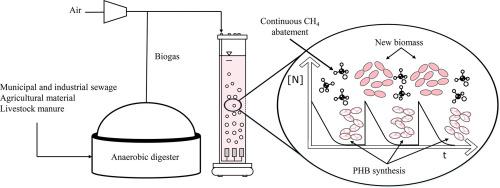Waste Management ( IF 7.1 ) Pub Date : 2020-06-22 , DOI: 10.1016/j.wasman.2020.06.009 Yadira Rodríguez 1 , Paulo Igor Milen Firmino 2 , Víctor Pérez 1 , Raquel Lebrero 1 , Raúl Muñoz 1

|
Creating additional value out of biogas during waste treatment has become a priority in past years. Biogas bioconversion into valuable bioproducts such as biopolymers has emerged as a promising strategy. This work assessed the operational feasibility of a bubble column bioreactor (BCB) implemented with gas recirculation and inoculated with a polyhydroxybutyrate (PHB)-producing strain using biogas as substrate. The BCB was initially operated at empty bed residence times (EBRTs) ranging from 30 to 120 min and gas recirculation ratios (R) from 0 to 30 to assess the gas-to-liquid mass transfer and bioconversion of CH4. Subsequently, the BCB was continuously operated at a R of 30 and an EBRT of 60 min under excess of nitrogen and nitrogen feast-famine cycles of 24 h:24 h to trigger PHB synthesis. Gas recirculation played a major role in CH4 gas–liquid transfer, providing almost fourfold higher CH4 elimination capacities (~41 g CH4 m−3 h−1) at the highest R and EBRT of 60 min. The long-term operation under N excess conditions entailed nitrite accumulation (induced by O2 limiting conditions) and concurrent methanotrophic activity inhibition above ~60 mg N-NO2− L−1. Adjusting the N-NO3− supply to match microbial N demand successfully prevented nitrite accumulation. Finally, the N feast-famine 24 h:24 h strategy supported a stable CH4 conversion with a removal efficiency of 70% along with a continuous PHB production, which yielded PHB accumulations of 14.5 ± 2.9% (mg PHB mg−1 total suspended solids × 100). These outcomes represent the first step towards the integration of biogas biorefineries into conventional anaerobic digestion plants.
中文翻译:

通过在气泡塔生物反应器中由甲基多孢霉(Methylocystis hirsuta)连续生产多羟基丁酸酯来实现沼气增值。
过去几年来,在废物处理过程中利用沼气创造更多价值已成为当务之急。沼气生物转化为有价值的生物产品(如生物聚合物)已成为一种有前途的策略。这项工作评估了气泡塔生物反应器(BCB)的操作可行性,该气泡反应器采用沼气作为底物,采用气体再循环并接种了产生聚羟基丁酸酯(PHB)的菌株。BCB最初在30到120分钟的空床停留时间(EBRT)和0到30的气体再循环比(R)下运行,以评估CH 4的气液传质和生物转化。随后,在过量的氮气和24小时:24小时的氮肥大饥荒循环下,BCB在R为30且EBRT为60分钟的情况下连续运行以触发PHB合成。气体再循环在CH 4气液传输中起主要作用,在60分钟的最高R和EBRT下,其提供的CH 4消除能力几乎提高了四倍(〜41 g CH 4 m -3 h -1)。在N过量条件下的长期运行需要亚硝酸盐积累(由O 2限制条件引起)并同时抑制〜60 mg N-NO 2 - L -1以上的甲烷营养活性。调节所述N-NO 3 -满足微生物氮需求的供应成功地阻止了亚硝酸盐的积累。最后,N饥荒24 h:24 h策略支持稳定的CH 4转化,去除效率为70%,同时连续产生PHB,产生的PHB累积为14.5±2.9%(mg PHB mg -1总悬浮固体×100)。这些成果代表了将沼气生物精炼厂整合到常规厌氧消化厂中的第一步。











































 京公网安备 11010802027423号
京公网安备 11010802027423号